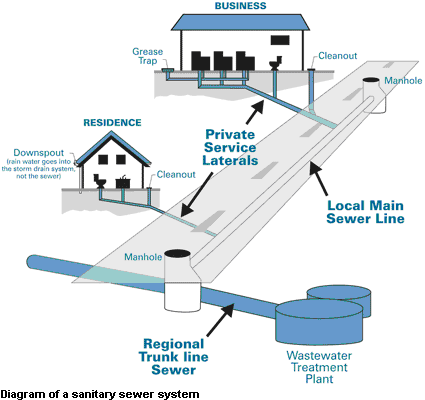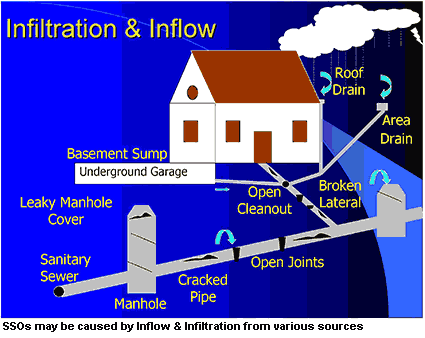General SSO Fact Sheet and Information
What do you do if you see an SSO occuring?
It is important to follow these guidelines if you see or come in contact with a Sanitary Sewer Overflow (SSO). SSOs have the potential to contain raw sewage. Raw sewage is likely to contain pathogens (disease-causing agents, such as bacteria) that can be harmful to our health. For that reason, it is important that you follow these steps to be a healthy, safe partner in water quality:
- Keep people away from the area of the overflow (typically a manhole). This is especially important for children and pets who may play near the overflow area (e.g., street, public park, or local streams, creeks, and rivers).
- Do not go near or touch the overflow. However, if you do happen to come in contact with the sewage overflow, wash your hands thoroughly in warm, soapy water before handling food or touching other persons or surfaces.
- Report leakages. If you see liquid coming out of a manhole cover with "Sanitary Sewer" on it, it is probably wastewater. Even if it’s not brown or yellowish in color, it still may contain sewage. Take note of the location of the overflow and report it immediately to the Department of Environmental Services.
It is critical that the overflow is stopped as soon as possible, and that proper cleanup takes place right away. Therefore, if you see an overflow occurring, please report it right away so that the Department of Environmental Services can begin their SSO Response and Cleanup Procedures.
REMEMBER: Report all sewer overflows
to the Department of Environmental Services.
Your quick action can help minimize the impacts!
SSO General Information
Sanitary Sewer Overflow (SSO) Information
This page provides information about sanitary sewer overflows (SSOs)…specifically what SSOs actually are and what to do if you encounter them. The Baton Rouge City/Parish Department of Environmental Services has developed a number of publications and other resources on the topic of sewer overflows presented on this page that enhance individual knowledge of SSOs with general facts, prevention paths, and steps to take if you see an SSO occurring.
What is an SSO?
A sanitary sewer overflow (SSO) is a discharge of untreated, raw wastewater into local waterways. The discharge may come from manholes, cracks and other defects in sewer lines, emergency relief outlets, and other sources within a sanitary sewer system.

SSOs occur for a number of reasons, including:
- Heavy rainfall events, which can cause massive infiltration of stormwater into sewerage lines
- Inflow into the sanitary lines caused by tree root rupture of underground pipes or by mechanical fracture due to age and overpressure from trucks and buildings above
- System failure, including power outage, which can disable lift station pumps or parts of the treatment plant operations themselves
- Inadequate hydraulic capacity of the collection system
- System bottlenecks caused by inadequate maintenance, system failures, improper grease disposal, or vandalism
- Overall deterioration of the sewer system
- Poor construction methods or materials

Distinctions are made between “wet weather” SSOs (those that result from rainfall) and “dry weather” SSOs (those that result from defects in the system or human error) because the methods used to fix each may be different. Generally, wet weather SSOs are reduced or eliminated by reducing inflow and infiltration (I/I), and/or maximizing or expanding the capacity of the conveyance and treatment systems. Dry weather SSOs can generally be resolved through operational improvements and increased maintenance.

SSOs can cause significant environmental and public health problems. They can pollute surface waters; endanger aquatic life; interfere with recreational uses and industry resources; and contaminate drinking water supplies. SSOs often contain high levels of suspended solids, pathogenic organisms, toxic pollutants, nutrients, oil, and grease. Typical consequences of SSOs include the closure of beaches and other recreational areas, inundated properties, interference with fishing and shellfishing, and polluted rivers and streams.
State and federal regulations now require the Baton Rouge City/Parish and other sewer agencies to reduce overflows and meet Clean Water Act requirements.
What can you do to prevent SSOs?
One cause of sanitary sewer overflows (SSOs) is blockage in sewer pipes. Excess rainwater entering pipes also causes overflows. You can help reduce or prevent SSOs by following a few simple rules:
- Disconnect downspouts, driveway or foundation drains, groundwater sump pumps or any other stormwater connection from the sanitary sewer system.
- Re-direct your downspouts so that rain soaks into your yard or garden.
- Install sump pumps help to keep your home dry by pumping ground water away from your foundation. They also must be drained into your lawn or yard area.
- It is prohibited and illegal to have the sump pump connected to the sanitary sewer. Such connections allow a tremendous amount of water to enter the system which, in turn, during wet weather causes the sanitary sewer to exceed the pipe's capacity and overflow into nearby ditches and streams or backup into downstream homes.
- You can help keep rainwater out of the pipes by landscaping your yard so that water flows away from your house and foundation drains, and by installing gutters to direct rainwater away from your house.
- Have the line that connects your house with the public sewer line (called a house lateral) inspected. Repairing broken laterals, which is the homeowner's responsibility, can reduce stormwater from leaking into pipes and prevent sewer backups into your home.
- Collect waste cooking oil in a can. Once the oil has cooled, place the can in a trash bag, seal tightly, and discard in the trash.
- Don’t scrape food from plates into your sink or garbage disposal; instead, wipe it off with a paper towel and compost it or toss it into the trash.
- Before washing, wipe oily pans thoroughly with a used paper napkin or paper towel.
- Recognize that fats may be found in a variety of foods – ice cream, gravy, mayonnaise and salad dressings contain fat that may clog pipes. Dispose of these items in the garbage can.
- Minimize or avoid using your garbage disposal. A lot of food waste contains fats, oils and grease and could clog your own pipes and/or the city's sanitary sewers.
- Install and maintain baskets, screens and or strainers over all sink and floor drains.
- For restaurants, an appropriate cleaning schedule must be followed in order for grease traps to function properly. Learn and follow local regulations.
Spread the word to your friends and neighbors about what we can do to help prevent SSOs!